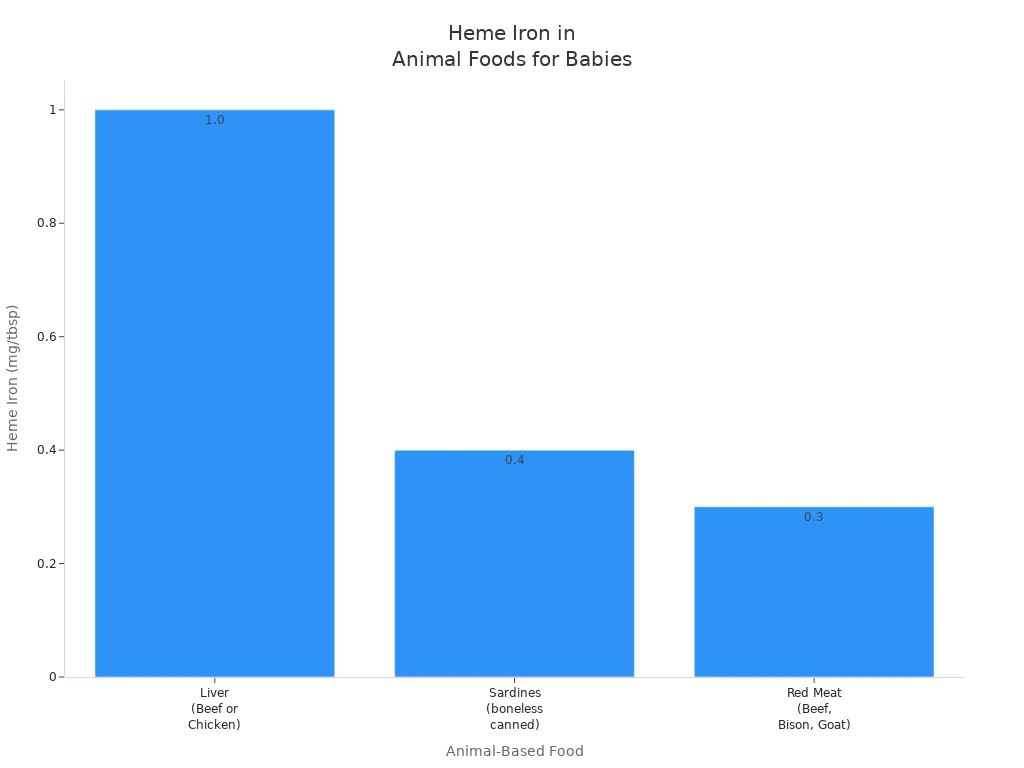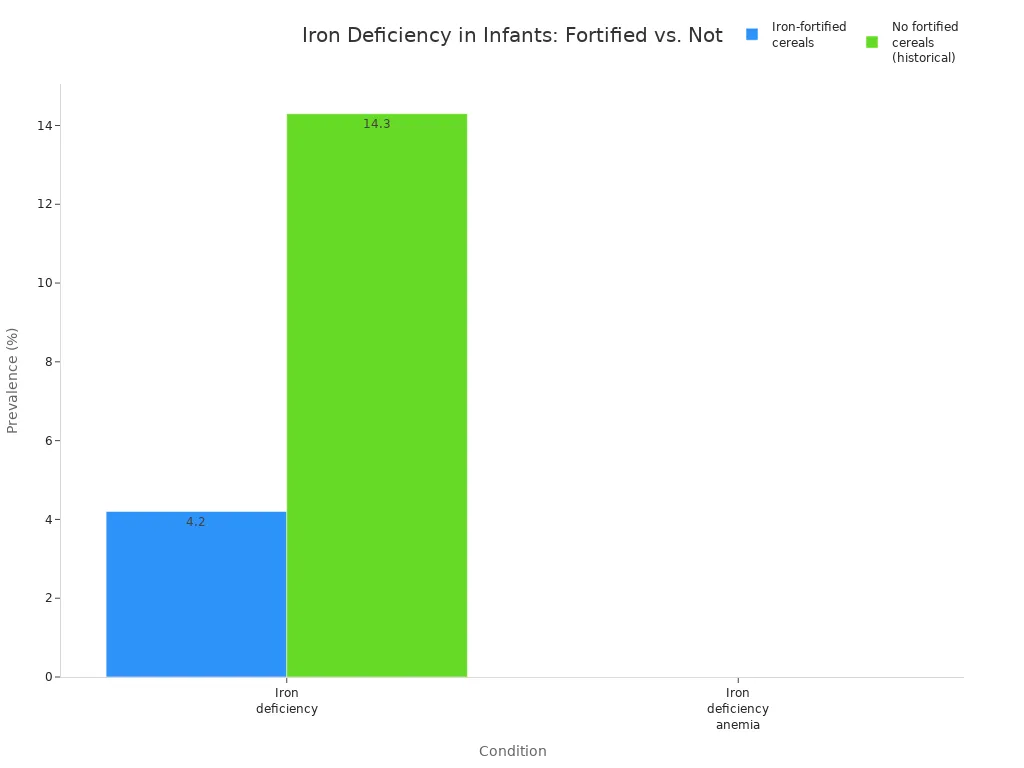You want the best for your baby, especially when it comes to their health. Iron plays a vital role in your little one’s brain growth and motor skills.
Without enough iron, babies may face lasting changes in brain structure, delayed development, and less social engagement.
Early life is a critical time, so choosing iron rich foods for babies makes a real difference. You can help your child thrive by offering the right foods at the right time, based on the latest research.
Key Takeaways
- Give your baby many iron rich foods every day. These can be animal based, plant based, or fortified foods. Iron helps your baby grow and helps their brain develop.
- Start giving iron rich solid foods at about six months. Begin with smooth purées first. Move to soft pieces as your baby gets older.
- Serve iron rich foods with vitamin C foods like fruits and vegetables. This helps your baby’s body take in more iron. Do not give cow’s milk before your baby turns one.
- Some babies are fussy eaters. Be patient and keep offering iron rich foods many times. Try mixing them with flavours your baby likes to help them eat more.
- Talk to your healthcare professional if you worry about your baby’s iron. This is important for premature babies or if you see signs of low iron.
Iron Rich Foods for Babies
Choosing the right iron rich foods for babies can feel overwhelming, but you have plenty of options. Let’s break down the best choices for your little one in 2025, with tips to make every meal count.
Animal Based Sources
Animal based foods offer the most easily absorbed form of iron, called heme iron. You can start introducing these foods around 6 months, especially if your baby is breastfed. Here’s a quick look at the top options:
| Animal Based Food | Approximate Heme Iron Content (mg/tbsp) | Key Benefits and Notes |
| Liver (Beef or Chicken) | ~1.0 mg | Packed with iron, vitamin A, and B12. Limit to once a week due to high vitamin A. |
| Sardines (boneless, canned) | ~0.4 mg | Great for iron and omega 3 fats. Supports brain growth. |
| Red Meat (Beef, Bison, Goat) | ~0.3 mg | Good source of iron and zinc. Offer several times a week for best results. |
| Chicken and Turkey | Lower | Less iron than red meats, but still useful in a varied diet. |

Tip: Try blending cooked liver with apple or pear purée. The sweetness helps balance the strong flavour and makes it easier for your baby to enjoy.
For red meat, aim for small, soft pieces or mince. You can offer about 20–30 grams per meal, two to three times a week. Always cook meat thoroughly and avoid processed meats like bacon or sausages.
Plant Based Sources
You might prefer plant based options, or want to add variety to your baby’s meals. Plant foods contain non heme iron, which is less easily absorbed, but you can boost absorption by pairing them with vitamin C rich foods like strawberries or tomatoes.
Here are some of the best plant based iron rich foods for babies:
| Plant Based Food | Approximate Iron Content per Serving | How to Serve for Babies |
| Tofu (3 oz) | 2.5 mg | Mash or cut into small cubes |
| Chickpea pasta (1 oz) | 3 mg | Cook until soft, mash if needed |
| Quinoa (½ cup) | 1.5 mg | Cook well, mash or mix with veg purée |
| Sprouted grain toast (1 slice) | 1 mg | Cut into strips for finger food |
| Hummus (3 Tbsp) | 1 mg | Spread thinly on toast or offer as dip |
You can also try:
- Lentils and beans (like black beans, kidney beans, chickpeas)
- Edamame
- Pumpkin seeds (finely ground)
- Smooth nut butters (almond, cashew, peanut)
- Leafy greens (spinach, kale)
- Wholegrains (teff, amaranth, quinoa)
Note: Always mash or finely chop beans and seeds to prevent choking. Mix lentils or beans into soups, stews, or purées for a gentle introduction.
Plant based diets can meet your baby’s iron needs. Just remember to add vitamin C foods to meals. For example, serve lentil purée with a side of mashed sweet potato or offer kiwi slices with hummus toast.
Fortified and Innovative Foods
Fortified foods make it much easier to meet your baby’s iron needs, especially if you worry about picky eating or low appetite.
Iron fortified infant cereals remain a top choice in 2025. These cereals come in oat, barley, multigrain, and rice varieties. You can mix them with breast milk, formula, or water for a smooth texture.
| Iron Fortified Food Type | Description and Effectiveness | Recommended Intake (6 12 months) |
| Iron Fortified Infant Cereals | Oat, barley, multigrain, and rice cereals with added iron. Rice cereal is good but use a mix of grains. | ~0.5 ounce equivalents per day |
| Red Meat | High in heme iron, more bioavailable than poultry. | 4.66–16 oz/week (6–9 months); 8.5–15.5 oz/week (9–12 months) |
| Poultry | Lower iron than red meat but still helpful. | 0.5–1.25 oz/week (6–9 months); ~1 oz/week (9–12 months) |
A recent study found that adding iron fortified cereals to the diet of breastfed babies increased their median iron intake from 2.9 to 8.8 mg per day.
The number of babies with low iron dropped from 92% to just 6%. That’s a huge improvement and shows how effective these cereals can be.

Tip: Rotate different types of iron fortified cereals and combine them with fruit or vegetable purées for extra flavour and nutrients.
You can also find new products in 2025, like chickpea pasta and sprouted grain breads, which offer extra iron and protein. Always check labels for iron content and choose products designed for infants.
Choosing a mix of animal based, plant based, and fortified foods gives your baby the best chance to get enough iron. With a little planning, you can make iron rich foods for babies a regular part of your family’s routine.
Why Iron Matters
Growth and Development
You want your baby to be strong and clever. Iron helps make this happen. Your baby’s brain grows fast in the first years. Iron helps brain cells get the oxygen they need. It also helps build links in the brain for learning and memory.
A study in rural Gambia found babies with good iron at five months do better on thinking tests later. These children process things faster and get higher scores up to age five. Iron helps with myelination, which wraps brain wires so messages move quickly. It also helps the hippocampus, which is important for memory.
Iron is not just for the brain. It helps your baby’s muscles and bones grow. It keeps energy up, so your baby can play and explore. Experts say the first 1,000 days are key for growth. Enough iron during this time gives your baby the best start for learning and moving.
Babies who get enough iron often have better attention, memory, and social skills as they grow.
Deficiency Risks
If your baby does not get enough iron, problems can start early and last for years. Iron deficiency is the most common nutrient problem in babies and young children. It can lead to iron deficiency anaemia, which affects how your baby thinks, moves, and interacts.
Here’s what can happen if iron runs low:
| Area Affected | What You Might Notice | When It Happens |
| Cognitive Development | Lower test scores, slower learning, weaker memory, and language delays | Infancy to school age |
| Motor Development | Poorer coordination, delayed milestones, weaker muscles | Infancy to preschool |
| Social Emotional Skills | Less energy, less talking, less play, more fussiness, trouble paying attention | Preschool and school age |
| Brain and Nerves | Slower brain development, lasting differences in how the brain works | Infancy and beyond |
Some studies show children with low iron as babies may have lower IQ and more trouble with attention at school age.
You might see your baby is tired, less playful, or not meeting milestones. If you worry about iron, talk to your health visitor or GP. Early help can make a big difference.
Iron Needs by Age
Daily Requirements
Your baby’s iron needs change quickly as they grow. In the first six months, most healthy babies have enough iron stored from birth. After that, their bodies need more iron from food. If your baby was born early (before 37 weeks), they may need extra iron even sooner.
Here’s a handy table to show you how much iron your child needs at each stage:
| Age Group | Recommended Daily Iron Intake |
| Preterm infants (<37 weeks), 1–12 months | 2 mg per kg body weight (breastfed) |
| Term infants, 4–12 months (breastfed) | 1 mg per kg body weight |
| 7–12 months (general recommendation) | 11 mg per day |
| 1–3 years | 7 mg per day |
| 4–8 years | 10 mg per day |
You can see that iron needs peak between 7 and 12 months. Babies grow fast during this time, so their bodies use up iron quickly. If your baby drinks formula with added iron, you usually don’t need to give extra supplements. For breastfed babies, you may need to add iron rich foods or supplements after six months.
Tip: Offer iron rich foods every day once your baby starts solids. Foods like red meat, lentils, and iron fortified cereals help meet these needs.
Signs of Low Iron
Sometimes, it’s hard to spot low iron in babies. You might notice small changes at first. Here are some common signs to watch for:
- Pale skin, especially on the palms or under the eyes
- Tiredness or weakness
- Irritability or fussiness
- Loss of appetite
- Brittle nails
- Sore or swollen tongue
- Rapid heartbeat
- Pica (eating things that aren’t food, like paper or dirt)
- Developmental delays or breath holding spells
- Sleep problems
If you spot several of these signs, it’s a good idea to talk to your health visitor or GP. Screening tests for iron can sometimes miss early problems, so your observations matter. Early action helps your baby stay happy, active, and ready to learn.
Introducing Iron Foods
When to Start
You might wonder when to begin offering iron rich foods to your baby. Most experts, including the World Health Organization, suggest exclusive breastfeeding for the first six months.
Around this age, your baby’s iron stores start to run low, so it’s time to introduce solid foods with plenty of iron. The CDC also recommends starting iron rich solids at about six months.
Many parents in the UK and Canada begin with iron fortified cereals or puréed meats between five and seven months. Trust your baby’s cues—if they can sit with support and show interest in food, they are likely ready.
Preparation and Texture
Safety and enjoyment matter most when you prepare iron rich foods. Start with smooth purées for babies aged six to eight months. As your baby grows, move to mashed or soft lumpy foods from eight to ten months. By ten to twelve months, you can offer small, soft pieces they can pick up themselves.
- Always cook meats, fish, and eggs thoroughly to kill germs.
- Try batch cooking and freezing small portions to save time.
- Offer new foods one at a time, waiting a few days before trying another, so you can spot allergies.
- Modify family meals by setting aside iron rich parts before adding salt or strong spices.
Tip: Use an iron pot for cooking. This simple switch can boost the iron content of your baby’s meals and help prevent iron deficiency.
Enhancing Absorption
You can help your baby get the most from every bite. Pair iron rich foods with vitamin C sources, like mixing lentils with sweet potato or serving beef with a little orange purée.
The “meat factor” in animal foods also helps your baby absorb more iron from plant foods. Avoid giving cow’s milk, tea, or high calcium foods during iron rich meals, as these can block iron absorption.
Instead, focus on a mix of meats, beans, and colourful fruits and vegetables to keep iron levels up and mealtimes fun.
Overcoming Challenges
Fussy Eaters
You might feel frustrated if your baby turns away from iron rich foods. Many parents face this challenge. You can try several creative tricks to help your little one accept new tastes:
- Cut deli meats or cheese into fun shapes using small cookie cutters.
- Mix ground meat with a splash of milk for a creamier, softer texture.
- Offer chicken nuggets as a familiar option, but check the label for salt and fat.
- Blend spinach or kale into fruit smoothies for a hidden iron boost.
- Puree favourite fruits like strawberries or peaches and freeze them into popsicles.
- Pair plant based iron foods, such as lentils or spinach, with vitamin C rich foods like oranges or peppers to help the body absorb more iron.
- Stick to regular meal times and let your baby decide how much to eat. Try not to pressure or bribe them.
- Eat together as a family and show your baby that you enjoy iron rich foods too.
- Keep offering a variety of iron rich foods, even if your baby refuses them at first. It can take many tries before they accept something new.
Tip: Patience pays off. Babies often need to see and taste a food several times before they start to like it.
Supplements
Sometimes, food alone does not meet your baby’s iron needs. This is more common in babies born early or with low birth weight. Your doctor may suggest iron supplements in these cases.
Here’s a quick guide:
| Age Group | When Supplements Are Needed | Dose (mg/kg/day) | How Long? |
| Low birth weight infants | All should get supplements | 2 | 2–23 months |
| 6–23 months (high anaemia) | If diet lacks iron fortified foods or high risk | 2 | 6–23 months |
| 24–59 months | If anaemia rates are high | 2 (max 30 mg) | 3 months |
Doctors recommend supplements for breastfed babies at four months if they are not eating iron rich foods yet. Supplements help prevent anaemia and support brain growth. Too much iron can cause problems, so always follow your doctor’s advice.
When to Seek Advice
You should talk to your health visitor or GP if you worry about your baby’s iron intake. Here are some times when you need expert help:
- Your baby was born early or with low birth weight.
- Your baby refuses all iron rich foods for several weeks.
- You notice signs of low iron, such as tiredness, pale skin, or slow growth.
- Your family follows a vegan or vegetarian diet.
- You want to know if your baby needs a blood test for iron.
- You have questions about supplements or special formulas.
Regular check ups help spot iron problems early. Your healthcare team can guide you on the best steps for your baby’s needs.
Meal Ideas
Sample Meals
You might wonder what a day of iron rich eating looks like for your baby. Here are some easy meal ideas you can try at home:
- Breakfast: Iron fortified infant cereal mixed with breast milk or formula. Add mashed strawberries or mango for a vitamin C boost.
- Lunch: Lentil and sweet potato purée. Serve with soft cooked broccoli florets on the side.
- Snack: Hummus made from chickpeas, spread thinly on sprouted grain toast. Offer slices of kiwi or orange alongside.
- Dinner: Mini beef or lamb meatballs cooked in tomato sauce. Pair with soft cooked quinoa or enriched pasta.
- Finger food: Slices of boneless sardines mashed with avocado, served on toast fingers.
- Porridge: Oats cooked with tahini and a sprinkle of ground hemp seeds. Top with mashed banana or pear.
Batch cooking these meals can save you time during the week. You can freeze small portions and defrost them as needed.
You do not need to count every milligram of iron. If you offer a mix of these foods each day, you will help your baby meet their needs.
Making Foods Appealing
Babies can be fussy, but you can make iron rich foods more fun and tasty. Here are some ideas to help your little one enjoy their meals:
| Iron Rich Food | Why It’s Great | How to Serve to Babies |
| Iron Fortified Cereal | Easy and reliable iron source | Mix with fruit purée or yoghurt |
| Liver (Beef or Chicken) | Packed with iron and vitamins | Mash into veg or cereal; spread on toast fingers |
| Lentils | Soft and mild flavour | Form into patties or blend with sweet red peppers |
| White Beans/Chickpeas | Creamy texture, gentle taste | Purée into hummus; mix with lemon or sweet potato |
| Hemp Seeds | Nutty and soft | Sprinkle on porridge or blend into smoothies |
You can also let your baby sprinkle seeds on their porridge or help mash beans. Pairing iron rich foods with colourful fruits and vegetables not only boosts absorption but also makes the plate look inviting. Keep mealtimes relaxed and let your baby explore new tastes at their own pace. Patience and variety will help your baby learn to love iron rich foods.
You give your baby the best start when you offer a mix of iron rich foods for babies. Trying new tastes and textures helps your child learn to enjoy healthy meals.
Studies show that early iron intake supports brain growth and protects against problems with learning and movement. If you use the tips in this guide, you can boost your baby’s iron every day. Stay patient and creative. If you still worry about iron, speak to your healthcare professional for advice.
FAQ
What if my baby refuses all iron rich foods?
You might feel worried, but this is common. Keep offering small tastes. Try mixing new foods with favourites. Babies often need to see a food many times before they eat it. Stay patient and positive.
Can I give my baby cow’s milk before one year?
You should wait until your baby turns one. Cow’s milk can lower iron absorption and may cause tummy troubles. Use breast milk or formula as the main drink until then.
Are iron supplements safe for babies?
Iron supplements are safe if your doctor recommends them. Never give supplements without advice. Too much iron can cause problems. Always follow the dose your healthcare professional gives you.
How do I know if my baby gets enough iron?
Look for signs like good energy, healthy skin colour, and steady growth. If you notice tiredness, pale skin, or slow development, speak to your health visitor or GP. They can check your baby’s iron levels



